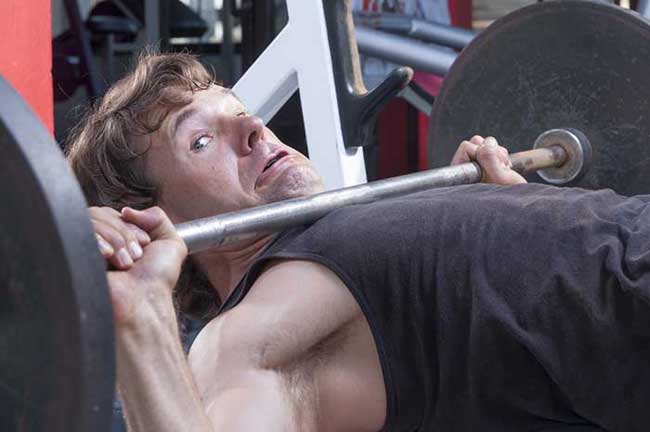If you repeat the same exercise on the same set of muscles you are likely to experience muscle failure. Trust me you don’t want to experience muscle failure!

Content Table
Training Your Muscles to Failure
Typically, you just cannot muster the strength for one more bench press.
Take a look around a typical gym full of bros and you’ll see a lot of them squeezing out their best pain face as they crank out the last few reps of their set.
That often means they are taking the set to muscle failure, otherwise known as the point when your muscles just won’t do another rep, no matter how strong your mind-muscle connection is.
Many of the same bros would tell you that training to failure is the best way to grow muscle. Some of them will say it’s the only way to grow muscle.
In fact, this has been the edict of many a professional bodybuilder over the years.
And who can argue with the very people who should absolutely know how to grow the biggest muscles, considering they have the largest muscles in the world?
But, is it necessary to do it every time your train? Should you take each muscle group to failure on each set? How many times should you do it a week? and is there an advantage to leaving some reps in the tank?
I’m going to cover all the answers to those questions, and possibly more. I’ll discuss some fancy research that’s put this very subject to the test, and I’ll provide you with some cool advice that you can immediately apply to your training in order to get more out of it.
Must Read: Build, repair, and recover faster with Crazy Nutrition’s TRI-PROTEIN formula. Made with 6 natural, non-GMO proteins that break down in 3 phases for more energy and strength than regular whey, hemp, or soy protein formulas
First, let’s start with the basics.
What is Muscle Failure?
Within the context of resistance training, it’s the point when your muscle/s can no longer generate adequate force to overcome the resistance and perform even a partial concentric contraction.

In other words; you can’t move the weight an inch.
Muscle failure is technically temporary, and might be called momentary concentric failure in pretty books about bodybuilding and strength training.
It’s temporary because you should be able to perform more contractions with the same load after you’ve taken a breather.
In fact, this momentary nature of muscle failure has led to many different set designs being thought up over the years, from the rest-pause method to completing multiple back-to-back drop-sets to failure.
What’s Good about Training to Muscle Failure?
Exhausting your muscle, sometimes repeatedly in a short space of time, has been used to improve rates of muscle protein synthesis and muscle hypertrophy – i.e. growth in terms of size and mass – for years.
Basically, the idea is that by working a muscle to its point of failure makes sure that as many motor units and thus muscle fibers as possible are recruited to keep moving the load.
That’s because as more and more of the initial fibers that were engaged at the start of the set become fatigued, the muscle needs more to help it generate the same total muscle force.
That in turn means that more muscle fibers are stressed under load, providing the stimulus for the supercompensation/growth that happens in the post-workout recovery stage.
Going to failure essentially ensures that no more of the muscle’s fibers could have been recruited.
That concept of leaving no room for doubt might actually be the only reason to train to failure, and I’ll get into why that is a bit later.

What’s Bad about Muscle Failure?
Longer recovery, decreased frequency, decreased volume, reduced intensity and higher probability of injury.
Okay, that sounds really bad, but it all makes sense when you think about it.
Longer Recovery
Training a muscle to failure implies a heavy reliance on anaerobic respiration and therefore lactate.
One can only work the muscle using lactate as an energy substrate for so long until muscle acidity rises to the point where it is too high for the conversion of glucose to occur at effective rates.
This acidity is commonly known as lactic acid, and it’s why our muscles fail.
Lactic acid is a good thing though because it prevents you from simply working the muscle until it wastes away. It’s a defence mechanism.
However, it causes soreness in the muscle, often proportional to how far you took your training. This can extend the recovery period of the muscle tissue, which can have knock on effects to your training.

Decreased Frequency
Of course, if a muscle or muscle group takes 4 days to recover instead of 2 because you ventured deep into the pain cave last time you trained, it can affect the frequency by which you can train.
Most trainers and coaches these days advise that you don’t train if you are sore. Obviously the whole situation varies from one individual to another, but soreness – sometimes referred to as delayed onset muscle soreness (DOMS) – is a good indicator for when you should train a body part again.
Light soreness is not really an issue but if the pain causes reduced function of the muscle it is probably best to let it rest some more as it is still recovering, growing and strengthening.
I’ll talk about soreness in more detail in a while. For now, suffice to say that it plays a role training frequency.
Soreness aside, the reduced capacity of muscle tissue following an intense lifting session can reduce training frequency. Simply put, you want to avoid overtraining because it can have many negative impacts, both in the short term and down the road.
Decreased Volume
From decreased frequency, a decrease in training volume is a definite possibility.
Weekly training volume is defined by the number of reps and sets you do in the seven days. Reduce the frequency and you can reduce the overall volume unless you increase the volume per workout to compensate.
That’s fine of course, and often part of the natural course of progressive overload. Progressive overload doesn’t always have to mean adding weight to the bar. It can also involve adding another set, say to your squat routine.
Training to failure too often can disrupt that progression.
After all, something has to give if you’re cooking the muscles to failure but trying to pump out the same volume and frequency as you would do if your sets actually left some reps in the tank.
That something can be training intensity, or the health of your joints, muscles and connective tissue.
Decreased Intensity
Generally speaking, if it takes more effort to lift the same weight for the same sets and reps as you did in your last workout, something is going wrong.
I say ‘generally speaking’ because sometimes there are understandable reasons for this, such as during cutting cycles, acute fatigue, nutritional timing etc. or any other short-term issue.
Intensity – at least in the context of bodybuilding – refers to the amount of weight your are lifting. It’s often referred to as a percentage of your 1RM (one rep max). And again, in general, it should increase for a given volume and frequency over time.
If training to muscle failure is preventing this increase from happening, or it is even causing your intensity to decrease, then it’s most certainly time to re-assess how often, or when, you are doing those failure sets.
Decreasing either of the other factors – volume or frequency – in order to maintain intensity is just as bad.

Increased Risk of Injury
This shouldn’t come as a huge surprise but weakening muscles by training them to their point of failure can heighten their potential for injury.
The risk of injury when lifting weights is extremely low, especially compared to other sports, as long as you are aware of your body’s capabilities and limitations.
Important Counterpoint
It’s worth noting that none of these points are inherently negative until they have a negative effect.
If that seems like I’m stating the obvious then let me use an example to explain: if training to failure reduces your overall volume, it’s only negative if you are set back in your progress as a result.
In fact, I’ve often heard people explain that reducing volume and adding some failure sets in is what broke them through a plateau. Ultimately, progress can be attributed to a combination of all the factors, and much of that is down to the individual.
Even the perceived increased risk of injury that’s associated with concentric muscle failure is theoretical. There’s no reason to assume the risk of injury is greater unless when it has been accommodated for.
For example, someone who performs free-weight back squats to failure in the open, nowhere near the safety bars of a power rack, is putting themselves vastly more at risk than someone doing arm curls to failure on a cable machine.
You can read part two here – Training To Failure – Muscle Soreness and Muscle Failure
